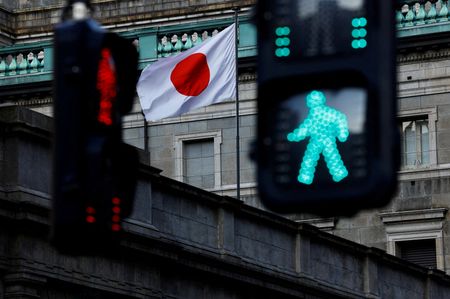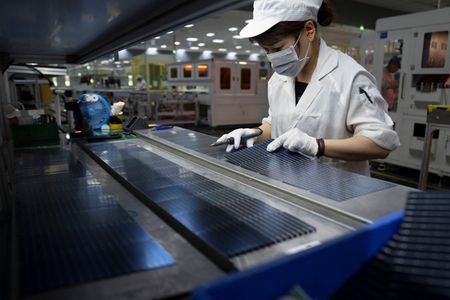By Leika Kihara and Makiko Yamazaki
TOKYO (Reuters) -The Bank of Japan revised up its inflation forecasts on Thursday and offered a less gloomy outlook on the economy than three months ago, keeping alive the possibility of a resumption in interest rate hikes this year.
The central bank also cited persistent rises in food costs as a potential driver of public perceptions around inflation and underlying price pressures.
“Underlying inflation still remains short of our 2% target, but is expected to rise moderately,” Governor Kazuo Ueda told a news conference.
“If headline inflation is high for very long, we must be mindful of the risk it could affect underlying inflation,” he said, stressing that the BOJ will scrutinise the extent to which companies will keep raising food prices.
In a widely expected move, the BOJ kept short-term interest rates steady at 0.5% by a unanimous vote.
The central bank maintained a pledge to keep hiking borrowing costs if economic and price developments moved in line with forecasts, adding that Japan will see rising wages and prices push underlying inflation towards the bank’s 2% target.
Japan’s trade deal struck with President Donald Trump this month lowers U.S. tariffs for imports of goods including its mainstay automobiles, easing the pain for the export-reliant economy and clearing a key hurdle for further BOJ rate hikes.
Ueda said the trade deal reduced uncertainty on the outlook and heightened the likelihood of Japan durably hitting the BOJ’s 2% inflation target – a prerequisite for further rate hikes.
However, he cautioned that the impact of higher U.S. levies on Japan’s economy remains uncertain.
“I don’t think the fog will clear immediately,” Ueda said.
Following the BOJ’s decision, Japanese stocks rose while the yen shed early gains as Ueda flagged continuing risks to the economic outlook in keeping interest rates steady.
NOT BEHIND THE CURVE
The BOJ said in its quarterly report that uncertainty over the impact of U.S. trade policy “remains high” – a less pessimistic view than in May when it said uncertainty was “extremely high.”
The central bank also sharply upgraded its inflation forecast for the current fiscal year and said risks to the price outlook were “roughly balanced.”
The price risk assessment was more hawkish than in May when it said risks were “skewed to the downside,” a sign the BOJ was growing more convinced Japan will make progress clearing hurdles for further rate hikes.
Underscoring its caution on mounting price pressure, the central bank also said rises in food costs could “persist for longer than expected” and have second-round effects on underlying inflation.
Ueda brushed aside suggestions the BOJ may be behind the curve in addressing inflation risk, saying that wages and service-sector inflation were rising but not at an alarmingly fast pace.
“I don’t think we’re behind the curve, or that the risk of us being behind the curve is large,” he said when asked whether the BOJ was being too cautious in managing price pressures.
“What stood out today was how the BOJ highlighted its focus on upward price pressure from rising food costs,” said Mari Iwashita, executive rates strategist at Nomura Securities.
“The BOJ may scrutinise data for two to three months, and hike rates in October at the earliest,” she said.
The BOJ revised up this fiscal year’s core consumer inflation forecast to 2.7% from 2.2% seen three months ago. It projected inflation to hit 1.8% in fiscal 2026 and 2.0% in 2027, a sign of its conviction inflation will stay around its target.
But the central bank downgraded its assessment on consumption for the first time since March last year, and warned it would stagnate for the time being, squeezed by higher prices.
The BOJ’s monetary policy shift began last year, exiting a decade-long stimulus programme and raising rates to 0.5% in January. A Reuters poll earlier this month showed a majority of economists expect another rate hike by year-end, underscoring the delicate balance the BOJ faces between supporting a fragile economy and managing inflationary risks.
(Reporting by Leika Kihara and Makiko Yamazaki; additional reporting by Kantaro Komiya and Satoshi Sugiyama; Editing by Sam Holmes, Lincoln Feast and Jacqueline Wong)











